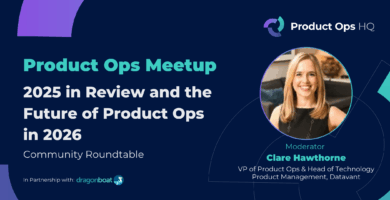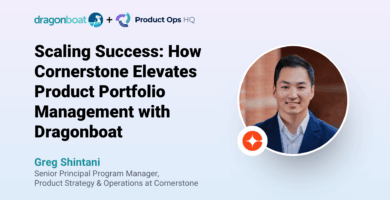Events • On Demand | Watch Time: 42 Min
How to Empower Product Teams While Delivering Commitments with Portfolio Management
Prioritization is the most challenging and impactful part of product portfolio management. But how do you structure a product organization’s needs to evolve as your company grows? How do you compare products across user journeys, market segments, technology components, or teams?
In the second part of this series, Becky will cover the Rock, Pebble, and Sand portfolio management approach and how it can be an effective way to prioritize across both products and portfolios.
Product operations exists to build effective product organizations that achieve the best portfolio outcomes. From building and training the team to improving and implementing processes and managing tooling for all stakeholders, product ops plays a critical role in driving outcome-focused product organizations forward.
Some of the topics include:
- Portfolio management in the context of autonomous teams and “big rocks”
- How to prioritize across multiple dimensions, products, and portfolios
- How to incorporate goals, customer segments, and product cadences in multi-dimensional roadmaps
In the last Insight Partners webinar, we discussed when portfolio management became essential. Unsurprisingly it becomes critical when we start to scale- more teams, more dependencies, and competing goals.
In part 2 of the webinar series, Becky Flint and Rachel Weston Rowell dive into “the how”. How do we apply portfolio management practices to empower teams?
3 Aspects to Consider When Implementing Product Portfolio Management:
- Change agent- to help reframe the problem
- Agile rollout- to create a responsive portfolio process
- Execute with the right tool- Using a product portfolio tool from the start will ease the transition from pure product management to product portfolio management
Change Agent: A change agent helps you reimagine your problem and product space. It helps the entire organization frame the problem space with a different way to look at the product.
Agile Rollout- with a responsive portfolio process: When we change the culture and how we work, it cannot go 0 to 100. It has to be done with an interactive rollout, both in terms of scope, and in terms of the number of people getting involved in the new process.
Execute with the right tool: Last but not least, having the right tool is critical to facilitate this change process. It’s very difficult to abstract how things work, so you end up having to train people multiple times. That’s why having the right tool at the start of the agile rollout process is critical, both in terms of the tool and the process. That, coupled with the right change agent, moves the company from a product management process into a responsive portfolio process.
Portfolio Management with Rock, Pebble, Sand Approach
“When we think about product teams as a whole, there’s one jar with lots of big rocks. As the company scales, when you start looking at a problem space, you have different focuses and goals. They are relevant, but they’re not always the same size or type. So the jar becomes how leaders define the focus. These are different dimensions you can look at.
Now, as the leader, not only do you need to define the focus, you also need to make sure you understand the resource allocation in order to size the jar. From there, you empower your team with a framework that guides them.”
– Becky Flint on creating the jars of Portfolio Management
Rock Pebble Sand Management gives you your high-level needs and allows you to visualize your dependencies so you can easily identify bottlenecks. That makes restructuring teams and adjusting much easier.
- Start the Rock Pebble Sand Product Management approach with your jars as this will represent what holds your resources. Define your jars (focus) and jar size (resource allocation) to better understand your company focus that quarter.
- The next step is filling your jars with rocks. These are your bigger impact items. By filling your jar with rocks first, you can prioritize easily. Naturally, you can begin to fill up the rest of your jars with pebbles and sand.
The Right Tool
“The right tool allows you to facilitate the best practices. Tool support will give you visibility, alignment, and insight into dependencies. That allows you to identify bottlenecks so you can move forward while understanding the risks so you can address them before it’s too late.”
– Becky Flint on why tools are so important to product portfolio management
About the Speakers
Becky Flint built and scaled product portfolio management at PayPal, Bigcommerce, Shutterfly, and Feedzai. She is the founder of Dragonboat, an integrated product portfolio platform that helps product teams strategize, prioritize, deliver and improve industry-leading products.
Rachel Weston Rowell has over 15 years of experience in agile and product leadership. As SVP, Product & Technology COE at Insight Partners, Rachel focuses on high-level business strategy and improving organizational discipline so they can successfully scale while aligned.
Watch the rest of the 3-part series.

Featured Speakers

Becky Flint
Founder and CEO of Dragonboat
Becky is a product and tech executive based in the Silicon Valley. She has built and scaled product and engineering teams globally for both startups and Fortune 500 companies. Currently Becky is the Founder and CEO of Dragonboat with a mission to empower responsive leaders and their teams to build better products faster. Prior to founding Dragonboat, Becky has held executive roles at Feedzai, Bigcommerce, Tinyprints/Shutterfly, and PayPal.

Rachel Weston Rowell
SVP, Product & Technology COE
Has over 15 years of experience in agile and product leadership. As SVP, Product & Technology COE at Insight Partners, Rachel focuses on high-level business strategy and organizational discipline so they can successfully scale while aligned.


